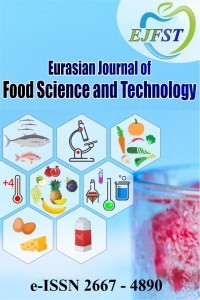Optimization of manufacturing parameters used safflower oil obtained by solvent extraction method for determination of oil properties
Optimization of manufacturing parameters used safflower oil obtained by solvent extraction method for determination of oil properties
___
- AOAC, 1990. Association of Official Analytical Chemists, Official methods of analyses. Washington, DC: Association of Official Analytical Chemists
- AOCS, 1989. Official Methods and Recommended Practices of the American Oil Chemists’ Society, 4th edn., edited by D. Firestone, American Oil Chemists’ Society, Champaign, Method Ca 5a-40.
- AOCS, 1993. Official Methods and Recommended Practices of the American Oil Chemists’ Society, 3rd edn., edited by D. Firestone, American Oil Chemists’ Society, Champaign, Method Cd 1-25, Corrected 1991.
- AOCS, 1994. Official Methods and Recommended Practices of the American Oil Chemists’ Society, 4th edn., edited by D. Firestone, American Oil Chemists’ Society, Champaign, Method Cc 13e-92.
- AOCS, 1997. Official Methods and Recommended Practices of the American Oil Chemists’ Society, 4th edn., edited by D. Firestone, American Oil Chemists’ Society, Champaign, Method Cd 8-53.
- Lutterodt, H., Slavin, M., Whent, M., Turner, E., & Yu, L. 2011. Fatty acid composition, oxidative stability, antioxidant and antiproliferative properties of selected cold-pressed grape seed oils and flours, Food Chemistry, 128,391–399.
- Mandal, V., Mohan, Y., & Hemalatha, S. 2008. Microwave assisted extraction of curcumin by sample–solvent dual heating mechanism using Taguchi L9 orthogonal design, Journal of Pharmaceutical and Biomedical Analysis 46, 322- 327.
- Porzucek, H., & Raznikiewicz, L. 1990. Fatty acid composition and lipoxygenase activity of flours and protein isolates from leguminous plants, Swedish Journal of Agricultural Research, 20, 31–34.
- Ross, P.J. 1989. Taguchi techniques for quality engineering, McGraw-Hill Book Company, New York.
- Weiss, E.A. 2000. Safflower In: Oilseed Crops, Blackwell Sci. Ltd, Victoria, Australia.
- Yu, L., Haley, S., Perret, J., & Harris, M. 2002. Antioxidant properties of hard winter wheat extracts. Food Chemistry. 78, 457-461.
- Yayın Aralığı: Yılda 2 Sayı
- Başlangıç: 2017
- Yayıncı: İlknur BAĞDATLI
Selahaddin Batuhan AKBEN, Selin KALKAN, Demet ÇANGA
Starch Based Sugar; Production, Usage and Health Effect
Gözde TÜRKÖZ BAKIRCI, Fatih ÇAKMAK
Hülya KARABAŞ, Semra BORAN, Samet ÇELEBİ
Nutrition for Functionality of Poultry Meat and Egg
Glycerol-Based Process Contaminants in Palm Oil
Tuğba ÖZDAL, Öznur YILDAR, Perihan YOLCİ ÖMEROĞLU
Chemical Migration from Plastic Types of Food Contact Materials
Perihan YOLCI OMEROĞLU, Tuğba ÖZDAL, Rüya BULUT
Determination of Table Olive and Olive Oil Consumption and Preference of Children from Yalova/Turkey
